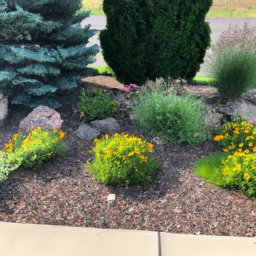Backyard Xeriscape Ideas
Backyard Xeriscape Ideas
Backyard Xeriscape Ideas
Xeriscaping is a type of landscaping that requires minimal water usage and maintenance. This sustainable practice is ideal for those who live in arid or dry climates. It utilizes low-water plants, rocks, mulch, and other materials to reduce moisture loss. Below are 8-12 essential themes to consider when creating a backyard xeriscape.
1. Low-Water Plants
When creating a xeriscape, the foundation is created with low-water plants. These include succulents such as sedum and agaves, cacti such as prickly pears and hedgehog cacti, as well as perennials like lavender, salvias, and yarrow. These plants require minimal water and thrive in dry conditions. Furthermore, they come in a wide array of colors and textures, making them easy to incorporate into any design.
2. Mulch and Rocks
In addition to plants, rocks and mulch are essential elements for xeriscape designs. Rocks are available in a range of sizes, shapes, and colors, which can be used to create pathways, borders, and focal points. Mulch helps conserve moisture and suppresses weeds. Additionally, it can be used to define an area or provide a finished look.
3. Design
When creating your xeriscape, design is key. A well-thought-out plan will ensure that the plants, rocks, and mulch work together seamlessly. Consider the existing terrain, sunlight, and soil type when designing your space. Furthermore, think about the overall look and feel of the design and how it will complement the architecture and style of your home.
4. Maintenance
When it comes to xeriscapes, the emphasis is on low-maintenance. To maintain your space, water your plants deeply and infrequently. Generally, a xeriscape only needs to be watered once every three weeks or so. Additionally, rocks and mulch need to be raked occasionally, and weeds should be pulled as needed.
5. Wildlife
Xeriscapes often attract wildlife such as butterflies, bees, and birds. To create a habitat for these animals, incorporate flowering plants and shrubs. Furthermore, create areas that provide shade and shelter, such as shrubs, trees, and even rocks.
6. Irrigation
To water a xeriscape effectively, incorporate an irrigation system that is appropriate for the size and type of design. Systems range from hand-watering and soaker hoses to drip, micro-spray, and central systems. When selecting an irrigation system, consider the size of the area, types of plants, and water pressure.
7. Edibles
Xeriscapes can also be used to grow food. Herbs and vegetables such as celery and spinach are particularly well-suited for dry climates. Additionally, hardy fruit trees such as citrus and figs also grow well in xeriscapes.
8. Lighting
Lighting is an important element for any landscape. For xeriscapes, consider low-voltage lighting such as solar-powered lights, LED lights, and spotlights. These types of lights emit a soft, natural light and are safe for plants. Additionally, they are energy-efficient and cost-effective.
9. Recycled Materials
Using recycled materials in xeriscapes is an excellent way to reduce waste. Old tires, bricks, broken glass, and other materials can be integrated into your design. Additionally, these materials add interest and texture to your landscape.
10. Care and Pruning
Like any other type of garden, xeriscapes need to be cared for to ensure their health and longevity. Pruning is particularly important for low-water plants as it ensures efficient air circulation and light exposure. Additionally, pruning also reduces overcrowding, encouraging healthy growth.
11. Drought-Tolerant Grass
In some xeriscapes, grass is included as a cosmetic filler or to add texture. If this is the case, opt for drought-tolerant grasses such as buffalo grass or blue grama. These grasses require minimal water and thrive in dry climates.
12. Wildflowers
Wildflowers are a popular and easy-to-maintain addition to xeriscapes. A wide array of annual and perennial wildflowers are available, providing pops of color and scent to your design.
Final Word
Creating a xeriscape is a great way to conserve water and cultivate a drought-tolerant outdoor space. Incorporating low-water plants, rocks, mulch, and drought-tolerant grasses into your design are essential elements for a successful xeriscape. Furthermore, keep in mind the elements of design, maintenance, and care when crafting your space. With careful consideration and planning, a backyard xeriscape will be a beautiful and sustainable addition to your home.
Takeaways
Low-water plants, rocks, mulch, and drought-tolerant grasses make up the foundation of a xeriscape.
Design elements such as terrain, sunlight, and soil type should be taken into account when crafting a xeriscape.
Xeriscapes require minimal water and maintenance.
Incorporate elements such as lighting, recycled materials, edibles, and wildflowers for added interest.
Create a habitat for wildlife with plants, trees, and rocks.
Care and pruning ensure efficient air circulation and light exposure.
With proper planning, a backyard xeriscape will be a beautiful and sustainable addition to your home.

Previous Page
Next Page
